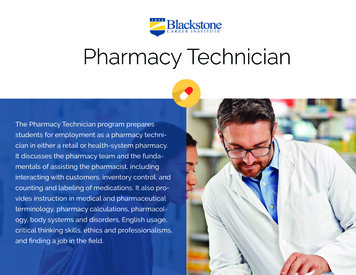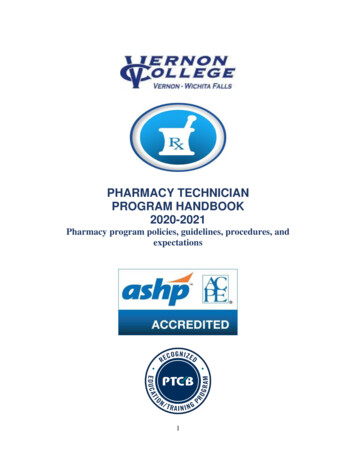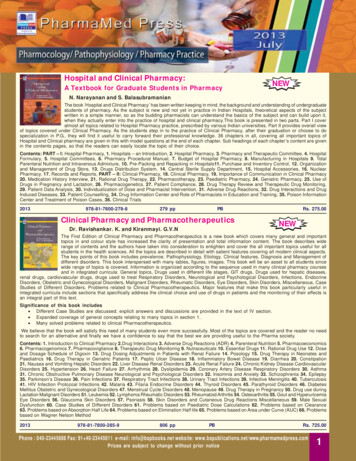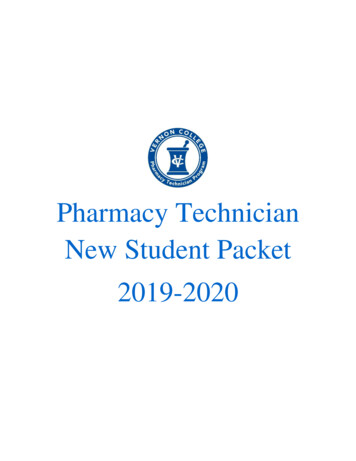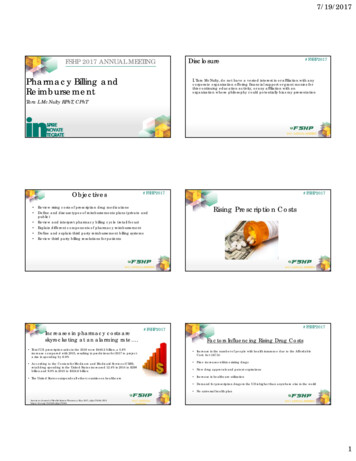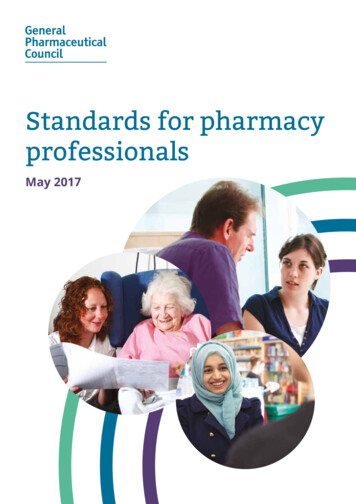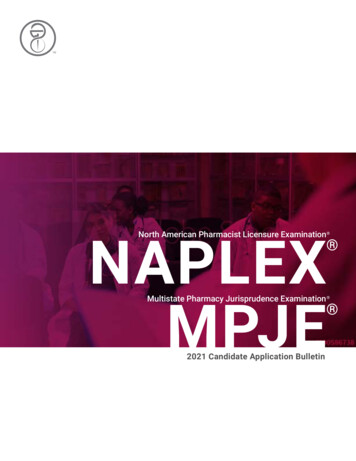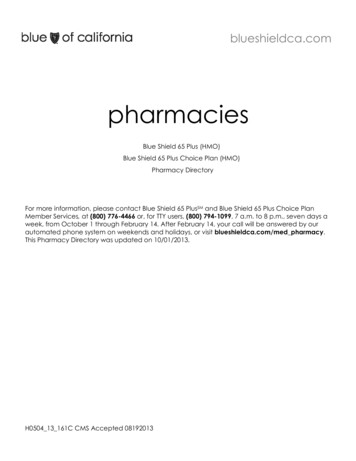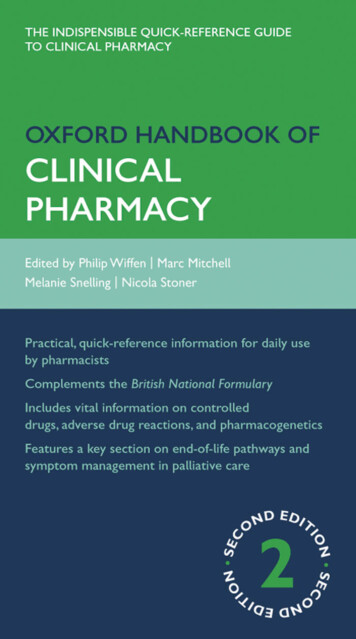
Transcription
OXFORD MEDICAL PUBLICATIONSOxford Handbook ofClinical Pharmacy
Published and forthcoming Oxford HandbooksOxford Handbook for the Foundation Programme 3eOxford Handbook of Acute Medicine 3eOxford Handbook of Anaesthesia 3eOxford Handbook of Applied Dental SciencesOxford Handbook of Cardiology 2eOxford Handbook of Clinical and Laboratory Investigation 3eOxford Handbook of Clinical Dentistry 5eOxford Handbook of Clinical Diagnosis 2eOxford Handbook of Clinical Examination and Practical SkillsOxford Handbook of Clinical Haematology 3eOxford Handbook of Clinical Immunology and Allergy 2eOxford Handbook of Clinical Medicine—Mini Edition 8eOxford Handbook of Clinical Medicine 8eOxford Handbook of Clinical Pharmacy 2eOxford Handbook of Clinical Rehabilitation 2eOxford Handbook of Clinical Specialties 8eOxford Handbook of Clinical Surgery 3eOxford Handbook of Complementary MedicineOxford Handbook of Critical Care 3eOxford Handbook of Dental Patient Care 2eOxford Handbook of Dialysis 3eOxford Handbook of Emergency Medicine 4eOxford Handbook of Endocrinology and Diabetes 2eOxford Handbook of ENT and Head and Neck SurgeryOxford Handbook of Expedition and Wilderness MedicineOxford Handbook of Gastroenterology & Hepatology 2eOxford Handbook of General Practice 3eOxford Handbook of Genitourinary Medicine, HIV, and Sexual Health 2eOxford Handbook of Geriatric MedicineOxford Handbook of Infectious Diseases and MicrobiologyOxford Handbook of Key Clinical EvidenceOxford Handbook of Medical DermatologyOxford Handbook of Medical ImagingOxford Handbook of Medical SciencesOxford Handbook of NeonatologyOxford Handbook of Nephrology and HypertensionOxford Handbook of NeurologyOxford Handbook of Nutrition and Dietetics 2eOxford Handbook of Obstetrics and Gynaecology 2eOxford Handbook of Occupational HealthOxford Handbook of Oncology 3eOxford Handbook of Ophthalmology 2eOxford Handbook of Oral and Maxillofacial SurgeryOxford Handbook of PaediatricsOxford Handbook of Pain ManagementOxford Handbook of Palliative Care 2eOxford Handbook of Practical Drug Therapy 2eOxford Handbook of Pre-Hospital CareOxford Handbook of Psychiatry 2eOxford Handbook of Public Health Practice 2eOxford Handbook of Reproductive Medicine & Family PlanningOxford Handbook of Respiratory Medicine 2eOxford Handbook of Rheumatology 3eOxford Handbook of Sport and Exercise MedicineOxford Handbook of Tropical Medicine 3eOxford Handbook of Urology 2e
Oxford Handbook ofClinicalPharmacySecond editionEdited byPhilip WiffenDirector of Training, UK Cochrane Centre,and Visiting Professor, Department of Pharmacy andPharmacology, University of Bath, UKMarc MitchellDivisional PharmacistSurgery, Cancer, Neurosciences & Critical CareOxford Radcliffe Hospitals NHS Trust, UKMelanie SnellingLead PharmacistHIV and Infectious DiseasesOxford Radcliffe Hospitals NHS Trust, UKNicola StonerLead Cancer PharmacistCancer Directorate and Cancer Research UKOxford Radcliffe Hospitals NHS Trust,and Principal Visiting Fellow, School of PharmacyUniversity of Reading, UK1
1Great Clarendon Street, Oxford OX2 6DPOxford University Press is a department of the University of Oxford.It furthers the University’s objective of excellence in research, scholarship,and education by publishing worldwide inOxford New YorkAuckland Cape Town Dar es Salaam Hong Kong KarachiKuala Lumpur Madrid Melbourne Mexico City NairobiNew Delhi Shanghai Taipei TorontoWith offices inArgentina Austria Brazil Chile Czech Republic France GreeceGuatemala Hungary Italy Japan Poland Portugal SingaporeSouth Korea Switzerland Thailand Turkey Ukraine VietnamOxford is a registered trade mark of Oxford University Pressin the UK and in certain other countriesPublished in the United Statesby Oxford University Press Inc., New York Oxford University Press, 2012The moral rights of the authors have been assertedDatabase right Oxford University Press (maker)First edition published 2007Second edition published 2012All rights reserved. No part of this publication may be reproduced,stored in a retrieval system, or transmitted, in any form or by any means,without the prior permission in writing of Oxford University Press,or as expressly permitted by law, or under terms agreed with the appropriatereprographics rights organization. Enquiries concerning reproductionoutside the scope of the above should be sent to the Rights Department,Oxford University Press, at the address aboveYou must not circulate this book in any other binding or coverand you must impose the same condition on any acquirerBritish Library Cataloguing in Publication DataData availableLibrary of Congress Cataloging in Publication DataData availableTypeset by Cenveo, Bangalore, IndiaPrinted in China on acid-free paper throughAsia Pacific OffsetISBN 978–0–19–960364–010 9 8 7 6 5 4 3 2 1
vForewordThe world we live and work in has changed, and continues to changerapidly. Clinical pharmacy is one area where change is at its most rapid,and the extent and speed of change poses a major challenge. Althoughthis book covers a huge amount of ground, perhaps three main areasstand out to a non-pharmacist looking over the pharmacist's shoulder.The first is the interpretation of clinical evidence about efficacy (oreffectiveness) and harm of medicines. The number of new medicines, andstudies of existing medicines, is exploding, producing more informationthan we can handle. The key to handling it is often to have good systematicreviews of good randomized trials, when the results will be secure.The second is to reassess how we look at harm. Adverse events thatare rare, but serious, will hardly ever be uncovered in randomized trialsbecause of insufficient numbers. The trend is to perform large observational database studies of clinical practice, often with millions ofparticipants; some of these will make us think again about medicines wehave always considered safe.The third is the translation of knowledge into clinical practice. There areany number of different ways this can affect clinical pharmacists—from useof expert computer systems to halve the rates of adverse drug reactions,to the generation of care pathways to deliver better outcomes forpatients with less hassle and at lower cost. This requires real managementskills—not bureaucracy, let me emphasize, which is what most of us seebadged as management.All three of these demand that clinical pharmacists have a range of skills,and the key is that they know and understand the tools of evidence-basedhealthcare. This includes management as well as knowledge of clinicaltrials in order to convert efficacy into effectiveness.The use of evidence is massively misunderstood. The most often useddefinition of evidence-based medicine is the ‘conscientious, explicit andjudicious use of current best evidence in making decisions about the care ofindividual patients.1 It is interesting that this was in response to a critic ofevidence-based medicine, John Grimley Evans, who made a very similarpoint: ‘Managers and trialists may be happy for treatments to work onaverage; patients expect their doctos to do better than that’.2Both of these emphasize the point that each of us is an individual, andthat we have to treat average results from trials or reviews with a degreeof caution, both for efficacy and harm. Robert Temple, a thoughtfulFDA researcher, has recently commented that ‘ whether accomplishedby sophisticated genetic or receptor analyses or by empirical observation ofresponse to treatment, there is growing recognition that people are not all thesame in the way that they respond to treatment and that groups that might1 Sackett DL, Rosenberg WM, Gray JA, Haynes RB, Richardson WS (1996). Evidence basedmedicine: what it is and what it isn't. British Medical Journal 312, 71–2.2 Grimley Evans J (1995). Evidence-based and evidence-biased medicine. Age and Ageing, 24, 461–3.
viFOREWORDrespond differently should be studied, a change from the established wisdom ofconducting trials with broad entry criteria while eschewing subset analyses’.3There are some intriguing results out there, relating differences in efficacyto genetic polymorphisms affecting drug absorption and metabolism, theway drugs pass the blood–brain barrier, as well as changes in receptors.Keeping up and coping with these changes is by no means going to beeasy, let alone incorporating them into clinical pharmacy. All we can besure of is that more change is on the way.Andrew MooreChief Editor, Bandolier20063 Temple RJ (2005). Enrichment designs: efficiency in development of cancer treatments. Journalof Clinical Oncology 23, 4838–9.
viiPreface to thesecond editionThe second edition of this book sees some significant revisions followingfeedback on the first edition and also developments in therapeutics. Wehave been encouraged to see the use of the first edition and also the production of the Oxford American Handbook of Clinical Pharmacy which hasborrowed extensively from our work.Clinical pharmacy services are only as good as the pharmacists whoprovide them, and there are still battles to be fought and won. It remainsa disappointment that clinical pharmacy in the UK has not embraced theacademic rigour seen in some countries and that the research cultureinbred into junior doctors has yet to infect pharmacists in the same way.This book is the distillation of 60–70 years of combined experiencebetween the authors with the hope that it will contribute to assisting clinicalpharmacists fulfil their potential. The book is organized into chapters thatfollow, we hope, a logical layout, with additional information organizedinto chapters designed to provide additional know-how. This handbookwas never perceived as a formulary, but hopefully it will provide wisdomthat can be used at the bedside, in the department, or on call.The Oxford Handbook series is well established and although pharmacists have used many of the volumes, this is the first is written specificallyfor pharmacists. We hope that it will prove useful to clinical pharmacypractitioners and teachers.PWMMMSNS2011
viiiPreface to thefirst editionOne of the authors began their clinical pharmacy career at a time whenpharmacists entered a ward with trepidation and more than once wasshouted at by a feisty ward sister protecting her territory. Since then,things have moved on a long way such that an internationally renownedsurgeon stated recently that clinical pharmacy (provided by his capableclinical pharmacist) was one of the best things anyone had provided forhim in his professional career.This illustrates, perhaps, that clinical pharmacy services are only asgood as the pharmacists who provide them and there are still battles tobe fought and won. It remains a disappointment that clinical pharmacyin the UK has not embraced the academic rigor seen in some countriesand that the research culture inbred into junior doctors has yet to infectpharmacists in the same way.This book is the distillation of 60–70 years of combined experiencebetween the authors with the hope that it will contribute to assistingclinical pharmacists fulfil their potential. The book is organized intochapters that follow, we hope, a logical layout with additional informationorganized into chapters designed to provide additional know-how. Thishandbook was never perceived as a formulary, but hopefully it will providewisdom that can be used at the bedside, in the department, or for on-call.The Oxford Handbook series is well established and although pharmacists have used many of the volumes, this is the first is written specificallyfor pharmacists. We hope that it will prove useful to clinical pharmacypractitioners and teachers.PWMMMSNS2006
ixAcknowledgementsWe are grateful to the following people who provided comments and help:John Beale, Sarah Cripps, Mrudula Patel, Rhoda Welsh, and Rebecca White.We are also grateful to the following reviewers:Jon Hayhurst, Phil Rogers, and Nicola Walker.
Oxford University Press makes no representation, express or implied, that the drugdosages in this book are correct. Readers must therefore always check the productinformation and clinical procedures with the most up-to-date published productinformation and data sheets provided by the manufacturers and the most recentcodes of conduct and safety regulations. The authors and publishers do not acceptresponsibility or legal liability for any errors in the text or for the misuse or misapplication of material in this work. Except where otherwise stated, drug dosages andrecommendations are for the non-pregnant adult who is not breastfeeding.
ContentsContributors xiiiSymbols and abbreviations erse drug reactions and drug interactionsAnaphylaxisClinical pharmacy skillsClinical trialsControlled drugsEvidence-based medicineHerbal medicinesMedical gasesPatient management issuesPatient-specific issuesPharmaceutical calculationsPharmaceutical careMedicines managementResearchTherapy-related issues: gastrointestinal systemTherapy-related issues: cardiovascular systemTherapy-related issues: respiratory systemTherapy-related issues: central nervous systemTherapy-related issues: infectionsTherapy-related issues: endocrine systemTherapy-related issues: obstetrics, gynaecology,and urinary tract disorders23 Therapy-related issues: malignant diseaseand 3255303313337389395411443459465
xiiCONTENTS2425262728Therapy-related issues: nutrition and bloodTherapy-related issues: musculoskeletal diseasesTherapy-related issues: skinTherapy-related issues: palliative careTherapy-related issues: miscellaneousAppendix: Supplementary dataIndex 649497547559577591627
xiiiContributorsSarah PooleJanet HemingwayPharmacy Department,Churchill Hospital,Oxford, UKLead Pharmacist,Nuffield Orthopaedic Centre,Oxford, UKLaura WatsonRebecca WhitePharmacy Department,John Radcliffe Hospital,Oxford, UKPharmacy Department,Churchill Hospital,Oxford, UKMatthew WhiteGwen KleppingPharmacy Department,John Radcliffe Hospital,Oxford, UKPharmacy Department,Churchill Hospital,Oxford, UKScott HarrisonElise CockrumPharmacy Department,John Radcliffe Hospital,Oxford, UKPharmacy Department,John Radcliffe Hospital,Oxford, UKMark BorthwickPharmacy Department,John Radcliffe Hospital,Oxford, UK
xivSymbols and abbreviationsid 45 easedgreater thanless thanmalefemaledegreesaccident and emergencyalive and wellabdominal aortic aneurysmairway, breathing, and circulationabdominalAssociation of the British Pharmaceutical Industryangiotensin-converting enzymeassist control ventilationadverse drug reactionatrial fibrillationacid-fast bacillialkaline phosphatasealanine aminotransferaseactivated partial thrombin timeankylosing spondylitisaspartate aminotransferasearea under the plasma concentration curvearteriovenousbilevel positive airway pressurebody mass indexbasal metabolic rateBritish National Formularyblood pressurebenign prostatic hyperplasiabody surface areacomplaining ofcontinuous ambulatory peritoneal dialysiscontinuous arteriovenous haemodialysis
SYMBOLS AND PAPCSFCTCCVCCVPCVSCVVHDFCXRCYP450DaDBPDDx, ZZDHxDICDMDOEDTIDUEDVTDx, ZE/CEBMECFECGeGFRESBLEUFHG6PDGABAcontinuous arteriovenous haemofiltrationcontrolled drugcongestive heart failurecommunity-acquired MRSAcontinuous mandatory ventilationcentral nervous systemcarbon dioxidecombined oral contraceptivechronic obstructive pulmonary diseaseControl of Substances Hazardous to Healthcontinuous positive airway pressurecerebrospinal fluidcommon toxicity criteriacentral venous cathetercentral venous pressurecardiovascular systemcontinuous venovenous haemodiafiltrationchest X-raycytochrome P450daltondiastolic blood pressuredifferential diagnosisdrug historydisseminated intravascular coagulationdiabetes mellitusdisease-orientated evidencedirect thrombin inhibitordrug-use evaluationdeep vein thrombosisdiagnosisenteric-coatedevidence-based medicineextracellular fluidelectrocardiogramestimated glomerular filtration rateextended-spectrum B-lactamasesEuropean Unionfamily historyglucose 6-phosphate dehydrogenaseG-aminobutyric acidxv
xviSYMBOLS AND VIxJVPK KCCTLFTLMWHLTOTM/RMAOIgood clinical practiceglomerular filtration rategastrointestinal systemgastrointestinal tractgood manufacturing practiceglucose oxidation rategastro-oesophageal reflux diseasegeneral practitionergeneral sales listglyceryl trinitrateglycosylated haemoglobinhaemodialysishigh-density duced thrombocytopeniahuman immunodeficiency virusHealth Protection Agencyhistory of presenting complainthepatorenal syndromehormone replacement therapyintra-arterialintracellular fluidintramuscularinvestigational medicinal productintermittent mandatory ventilationinternational normalized ratiointra-osseousInstitute of Purchasing Supplyintensive therapy unitintravenousinvestigationsjugular venous pressurepotassiumkaolin cephalin clotting timeliver function testlow molecular weight heparinlong-term oxygen therapymodified-releasemonoamine oxidase inhibitor
SYMBOLS AND molecular absorbent recirculating systemmean corpuscular haemoglobinmean corpuscular haemoglobin concentrationmean cell volumeMedical Devices Agencymetered-dose inhalermonitored dose systemMedicines and Healthcare Products Regulatory Agencymyocardial infarctionminimum inhibitory concentrationmonoamine oxidase inhibitormeticillin-resistant Staphylococcus aureusmeticillin-susceptible Staphylococcus aureusnil by mouthnanogramnasogastric tubeNational Health ServiceNational Institute of Health and Clinical Excellencenumber needed to harmnon-nucleoside reverse transcriptase inhibitornumber needed to treatNational Patient Safety Agencynon-steroidal anti-inflammatory drugNational Service Frameworknon-ST-segment elevation myocardial infarctionNew York Heart Assocationon examinationoxygenbones and jointspsoriatic arthritispara-amino benzoic acidpartial pressure of carbon dioxide in arterial bloodpartial pressure of oxygen in arterial bloodpresenting complaintprothrombin complex concentratepercutaneous coronary interventionpulmonary embolismPositive end-expiratory pressurepercutaneous endoscopic gastroscopypatient group directionxvii
xviiiSYMBOLS AND SHSIMVSOBSPCSRSSRIstatSTEMIT3T4TmaxTBperipherally inserted central catheterPrescription Medicines Code of Practice Authoritypast medical historyprescription medication recordspre-menstrual syndromeperipheral nervous systemper os (by mouth)patient’s own drugpatient-orientated evidence that mattersprescription-only medicinepostoperative nausea and vomitingprogestogen-only pillproton pump inhibitorparts per millionper rectum (by the rectum)pro re nata (as required)pressure support ventilationprothrombin timepeptic ulcer diseasequalified personrheumatoid arthritisred blood cellrespiratory systemRoyal Pharmaceutical Society of Great Britainshort-burst oxygen therapysystolic blood pressuresubcutaneous/lysystems reviewsocial historysynchronous intermittent mandatory ventilationshort of breathsummary of product characteristicssinus rhythmselective serotonin re-uptake inhibitorat onceST-segment elevation myocardial infarctiontri-iodothyroninethyroxinetime to maximum drug concentrationtuberculosis
SYMBOLS AND WHOto be confirmed/awaiting confirmationthyroid-binding globulintherapeutic drug monitoringtranscutaneous electronic nerve stimulationtriglyceridetransient ischaemic attacktotal parenteral nutritiontumour necrosis factorthyroid peroxidasethyrotrophin-releasing hormonethyroid-stimulating hormonetissue plasminogen activatorurea and electrolytesunfractionated heparinUK Medicines Informationvolume in volumevolume in weightvacuum-assisted closurevisual analogue scalevalue added taxventricular fibrillationvancomycin resistant enterococcivancomycin resistant MRSAventricular tachycardiavenous thromboembolismvenovenouswhite cell countweight in volumeweight in weightWorld Health Organizationxix
This page intentionally left blank
Chapter 1AdherenceIntroduction to adherence 2Assessing adherence 4Strategies to improve adherence 6Adherence counselling 8Writing patient information leaflets 101
2CHAPTER 1AdherenceIntroduction to adherenceWhat is adherence?‘To be taken as directed’ is an instruction that frequently appears onmedicine labels. It suggests that a patient will obey the doctor’s ‘orders’without question. However, as most pharmacists are well aware, patientsfrequently choose not to ‘take as directed’.‘Compliance’ is a term used to describe whether or not a patient takestheir medicines as directed. It implies a paternalistic relationship betweenthe doctor (or other healthcare professional) and the patient, with little, ifany, discussion or negotiation.‘Concordance’ is a two-way exchange between healthcare professionaland patient. The patient participates in both the consultation and thedecision-making process, and the patient’s preferences and beliefs aretaken into account. However, this rarely happens in full in a busy generalpractitioner’s (GP’s) surgery, hospital ward, or out-patient clinic.‘Adherence’ is somewhere between compliance and concordance. Thehealthcare professional accepts that the patient’s beliefs, preferences,and prior knowledge influence medicine-taking and attempts to addressthis. However, adherence interventions are frequently made after theprescription is written and the patient might not have had much influenceon the choice of drug. Consequently, pharmacists and specialist nursestend to have a bigger role in facilitating adherence than doctors.Concordance requires a high level of resources and a multidisciplinaryeffort. However, adherence support can be carried out by pharmaciststo some extent in their everyday practice. Thus this discussion willconcentrate on adherence.Why is adherence important?It is estimated that, on average, 50% of patients on long-term therapy donot take their medicines ‘as directed’. The costs of this are potentially significant on both personal and public levels. It is estimated that up to 30%of drug-related hospital admissions result from non-adherence. In onestudy, 91% of non-adherent renal transplant patients experienced organrejection or death compared with 18% of adherent patients.1 The cost ofwasted medicines and i health expenditure to treat uncontrolled diseaserepresent a significant public cost.Why do patients not take their medicines?Numerous studies have attempted to identify the causes of non-adherenceand many factors have been identified (Table 1.1). Different factors arerelevant to different diseases or settings; for example, cost is an issue inthe USA (because patients have to pay for medicines/health insurance)but rarely in the UK. The reasons for non-adherence generally fall intotwo categories: involuntary or behavioural (e.g. simply forgetting) voluntary or cognitive (e.g. concerns about side effects).1 De Geest S et al. (1995). Incidence, determinants, and consequences of subclinical noncompliancewith immunosuppressive therapy in renal transplant patients. Transplantation 59: 340–7.
INTRODUCTION TO ADHERENCEPharmaceutical manufacturers tend to concentrate on behavioural factors—producing combination tablets or once-daily versions of their medicines,which are supposedly easier to take. There is evidence to suggest thatadherence is reduced if the dose frequency is more than three times daily,but no data are available to support once-daily over twice-daily dosing.Patients might prefer combination products or once-daily dosing, but preference does not necessarily relate to adherence. Once-daily dosing could,in fact, lead to a worse therapeutic outcome because missing one dosemeans missing a whole day’s therapy.Many adherence strategies focus on cognitive issues. Intuitively it seemsright that if patients do not adhere because of fears or misconceptionsabout their medicines, addressing these issues should improve adherence.However, it is not clear whether non-adherent patients lack knowledge andunderstanding or whether these are the patients who fail to seek advice.Ultimately, it is the patient’s, not the healthcare professional’s, agendathat influences whether or not they take their medicines.Table 1.1 Factors reported to affect adherenceAbility to attend appointmentsAgeBeliefs about medicinesChaotic lifestyleComplexity of regimenConcerns about confidentialityCostCultural practices or beliefsDepressionEducational statusFrequency of dosesGenderHealth beliefs and attitudes (towards self and others)Impact on daily lifeLanguage (if the patient’s first language is different from that of healthcareprofessional’s)LiteracyManual dexterityPast or current experience of side effectsSatisfaction with healthcareSelf-esteemSide effectsSocioeconomic status3
4CHAPTER 1AdherenceAssessing adherenceVarious methods of measuring adherence have been developed, but noneof them is entirely satisfactory. Treatment response—the most clinically relevant method of assessingadherence. If the patient has been taking their medicines, logicallytheir health should improve (assuming that the choice of therapywas appropriate). A reasonably non-invasive and simple marker oftreatment success is necessary (e.g. measuring blood pressure (BP) orcholesterol levels). However, some markers might only show recentadherence (e.g. blood glucose levels). Therapeutic drug monitoring (TDM)—this has limited use for assessingadherence. If serum levels are within the therapeutic range, recent,but not long-term, adherence can be assumed. Sub-therapeutic levelscan be an indicator of erratic or recent non-adherence, but could alsoreflect malabsorption of the drug or a drug interaction. Medicines event monitoring systems (MEMSs)—these are special bottlecaps that record each time the bottle is opened. The information canbe downloaded so that each time and date the bottle was opened canbe read. However, MEMS caps can only record whether the bottle hasbeen opened, not whether any drug (or how much) was taken out ofthe bottle. Ideally, they should be used in conjunction with some formof patient diary so that if the bottle is opened or not opened for somereason (e.g. taking out two doses at once), this can be recorded.MEMS caps are expensive and are usually only used in clinical trials.Blister-packed medicines have to be popped into a suitable container,which can be time consuming and inconvenient. Pharmacy records (refills)—these can be used to check whether thepatient collects the correct quantity of tablets each time, so that theydo not run out if they have been taking their drugs correctly. However,this system cannot determine whether the patient actually takes thetablets. Patient self-report—the patient should be asked (in a non-judgementalway) whether they have missed or delayed any doses, and if so, howmany. Patients tend to overestimate their level of adherence and couldgive the answer they feel the enquirer wants to hear rather than atrue picture. However, patient self-report correlates well with othermeasures and is relatively cheap and easy to do.
This page intentionally left blank
6CHAPTER 1AdherenceStrategies to improve adherenceNumerous strategies have been used to attempt to improve adherence,but there is little evidence that any of them are effective in the long term.Interventions to support adherence are discussed here.Monitored dose systems (MDSs)MDSs (‘dosette boxes’) are useful for patients who might have difficultyunderstanding or following instructions—because of language, learning, ormemory problems. Different types of box are available and it is importantto ensure that the patient has the dexterity required to use them. Thereis no guarantee that the patient will actually take their tablets, but MDSsprovide a useful check for whether or not a dose has been taken—if thetablets are still there, clearly the dose has been missed, but an absence oftablets doesn’t necessarily mean that the tablets have been swallowed.MDSs are time consuming to fill and pharmacists must ensure that if apatient starts to use an MDS in hospital, a continuing supply of filled MDSscan be ensured in the community. MDSs can only be used for solid-doseformulations and are not suitable for hygroscopic tablets (e.g. sodiumvalproate), ‘as required’ drugs (e.g. analgesics), or variable-dose medicines(e.g. warfarin).AlarmsAlarms, bleeps, and phone calls have all been used to remind patientsto take their medicines. Many patients find it useful to set the alarm ontheir mobile phone because this is less obvious than a special alarm. Textmessaging has also been used to remind patients to take their tablets, butthis requires a system to be set up to send the messages and should onlybe done with the patient’s consent.Refill/follow-up remindersPatients who attend follow-up clinics and collect refill or repeat prescriptions are more likely to adhere to their medication regimen. Adherencesupport should not just concentrate on medicine-taking, but also ensurethat the patient adheres to other therapies, out-patient appointments, etc.Keeping the patient engaged with the whole of their care could be themost important adherence intervention.Regimen simplificationPatients who have to take their medicines more than three times daily areless likely to adhere fully to their regimen. Further complications, such ashaving to take medicines with food or on an e
Clinical pharmacy is one area where change is at its most rapid, and the extent and speed of change poses a major challenge. Although this book covers a huge amount of ground, perhaps three main areas stand out to a non-pharmacist looking over the pharmacist's shoulder. The fi rst is the interpretation
